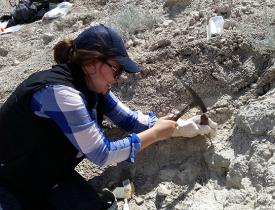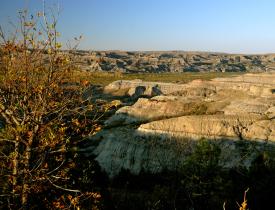Big Bones. Local Stories.
Traveling to western North Dakota brings you to the open plains, the rugged buttes and wide-open spaces. What you see today was once a land of tropical forests, wetlands and prehistoric wildlife. There was no season to hunt creatures back then. The wildlife was dinosaurs!
Overwhelmingly dominant, they roamed wherever they wanted, ate whatever they wanted and lived a life that was quite different than what they would have experienced on today’s landscape.
Did they birth newborns, or were they hatched? Did they eat palm trees, or did they eat each other? Did they travel in groups or by themselves? Why did they disappear? These questions are all part of the experience that you can learn about at the Dinosaur Museum in Dickinson. Dr. Denver Fowler, resident paleontologist at the Dinosaur Museum, is gathering new specimens and offers insight to these types of questions to people when they visit the museum.
Along with the area’s prehistoric wildlife, the Badlands Dinosaur Museum houses a large mineral collection that fascinates with color, sparkle and glow-in-the-dark features. Bright blues, intense auburns and white powder-puff forms are eye-candy to see but even more interesting to learn about and how they were formed.
Long after the dinosaurs came the settlers. Cattlemen, sodbusters and rail gangs all took on the challenges of life on the Great Plains. Imagine yourself an immigrant with little more than a few coins in your pocket, facing an unbroken land that dares you to plow your way to prosperity, or maybe you’re rounding up cattle in the spring, hoping your livestock survived a brutal winter. The Joachim Regional Museum shows the history where you can judge your skills yourself.
Bucking up hay, cultivating corn or harvesting grain all took large machines and horsepower: the four-legged-kind. Pioneer women often worked beside the men in the fields, finishing off their day with household chores in their small prairie shanties or sod homes. The Pioneer Machinery Hall will show you the tools and trappings that helped make the Great Plains America’s breadbasket.
In the 12-acre Prairie Outpost Park, you’ll walk through original buildings from the plains settlements of southwest North Dakota and visit reproductions of ethnic architecture that reflect the influence of immigrant settlers. Summertime guided tours stroll through this unique outdoor historical resource.
Get more information by calling 800-279-7391 or visiting www.visitdickinson.com.











